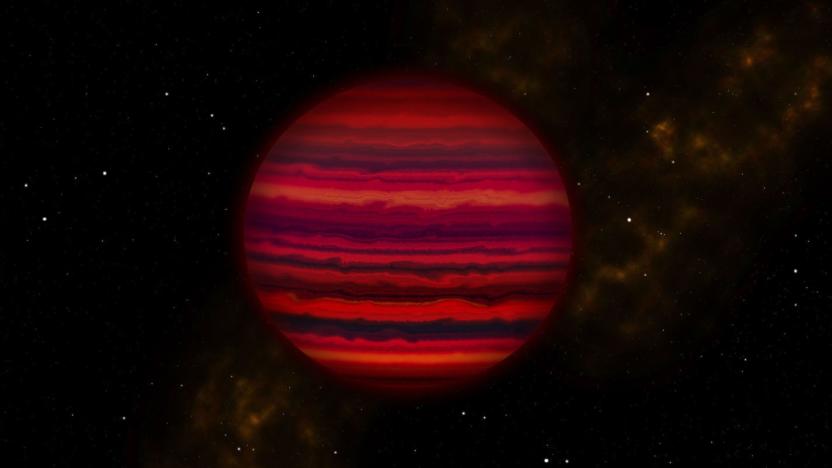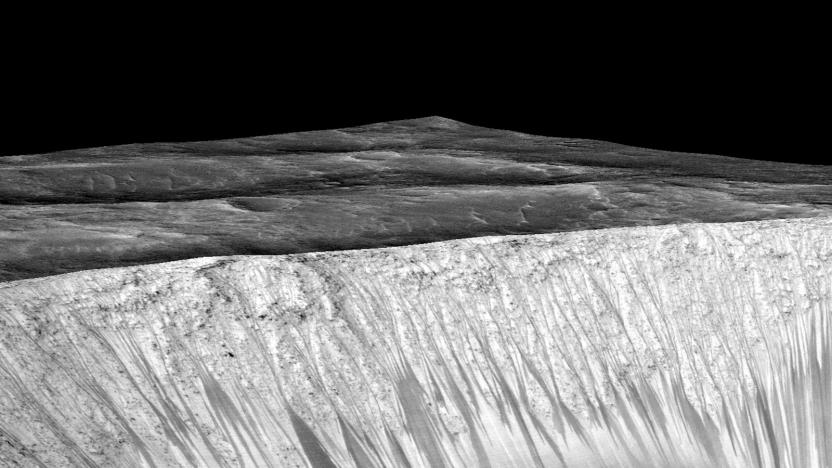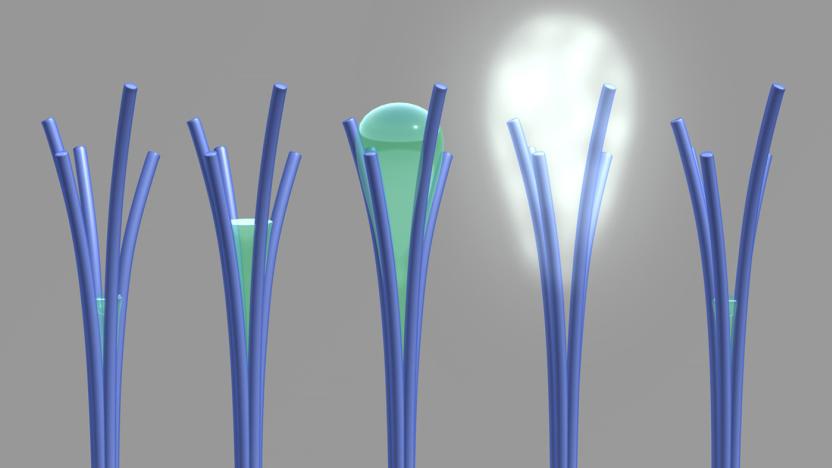water
Latest

Scientists find the first water clouds beyond the Solar System
At last, astronomers have found evidence of watery clouds beyond our home star... only they're not hovering around a planet, like you might expect. UC Santa Cruz-led researchers have discovered signs of water vapor clouds around WISE 0855, a brown dwarf (that is, gas and dust that failed to become a star) a relatively close 7.2 light years away. The team had to use tricky infrared spectrum analysis to spot signs of water absorption around the dwarf, which is so cold and faint (-10F) that visible light and near-infrared studies wouldn't work.

328 foot-long floating barrier will collect ocean trash
There are numerous efforts underway to clean the world's oceans, but The Ocean Cleanup is testing what may be both the simplest and the most ambitious. It just launched a 328 foot-long prototype floating barrier that will collect trash floating in the North Sea. If it can survive the rough conditions of those waters, the plan is to deploy a 62 mile-long (!) barrier in the Pacific Ocean and reduce the size of the notorious Great Pacific Garbage Patch -- the hope is to halve the size of the trash field in 10 years.

Curiosity rover may sample Mars water
Scientists have already found hints of liquid water on Mars... now, they want to take a close look at it. NASA has revealed that the Curiosity rover will investigate recurring slope lineae (those streaks you see above) around Mars' Gale Crater in hopes of finding water. It'll first take a photo with its mast camera to verify that there's water in the first place. If there is, the machine will head over to collect samples. The agency would like to take those photos within a year, so you wouldn't have to wait too long to get answers.

ICYMI: An accidental invention could create clean water
Today on In Case You Missed It: Some of the greatest inventions of our modern age, from the pacemaker to super glue, got their start as accidental discoveries. That's why we're focusing today's show on a find by the Pacific Northwest National Laboratory, where scientists meant to make magnetic nanowires but created a kind of carbon nanorod instead. It might prove to be a wonderful mistake, since studying the nanorods shows they can harvest, hold and evaporate liquid from their fibers. The hope is that the material could create cheap and low-energy water purification systems, changing the game for clean water delivery. We also showed you both the YouTube video where a ATM skimmer seller demonstrates how easy it is to scam money from those machines, and also a video of this dancing robot, because. As always, please share any interesting tech or science videos you find by using the #ICYMI hashtag on Twitter for @mskerryd.

Nanorods could harvest water in dry climates
Sometimes it's the accidental discoveries that make the biggest impact. Researchers at Pacific Northwest National Laboratory have learned that carbon-rich nanorods created in a botched experiment might be ideal for harvesting water. When there's relatively low humidity (below 50 percent), the rods trap water inside their gaps; if it's any more humid, however, they promptly expel that water as vapor. It's a very unusual trait that's likely caused by water condensing into a "bridge" in the nanorods, whose surface tension forces them to close and eventually kick the water out.

Stanford looks to the skies to calculate underground water
A team at Stanford has pioneered a new use of satellite imagery that could help its home state avoid future water supply issues. Previous Stanford research had already proved satellite images (specifically Interferometric Synthetic Aperture Radar) of minute changes in ground elevation could provide reliable clues to underground water flow. The problem was, only tiny sections of the images provide useful data, and analyzing them is a laborious, manual process. Hopefully not for long.

Most of the Moon's water might have come from asteroids
For a while, scientists believed that water inside the Moon largely came from comets. However, they might have to rethink that belief. Researchers looking at Apollo mission lunar samples now suspect that most of the Moon's water came from asteroids smacking into the celestial body between 4.3 billion and 4.5 billion years ago, when it (and the Earth) was covered in a magma ocean. The key was to look at hydrogen isotopes. While comet water tends to be rich in deuterium, less than 20 percent of the Moon's water shows signs of it -- the isotope ratios were generally closer to that of the Earth, pointing to an asteroid origin.

ICYMI: Smart coats, robot whiskers and vaporizing lasers
Today on In Case You Missed It: Google and Levi's team up to make a smart Canadian Tuxedo jacket, the University of Bristol teaches a whiskered robot to react to stimuli and Stanford's Linear Accelerator fries water droplets with an X-ray laser, because science!

This is how you make subaquatic music
Water is a pretty strange compound. Since it's so dense, it drops the volume of sounds compared to what you'd hear on the surface. At the same time, it causes sound to travel much faster than it does through air, by roughly 400 percent. Neither of these really affect us on a day-to-day basis, but then again, we aren't performing a concert from the confines of an aquarium. We'll leave that up to AquaSonic, a band whose vocalist, according to New Scientist, devised her own singing technique to ensure that she could belt out her subaquatic notes without creating a bunch of bubbles in the process.

Solar cell generates power from raindrops
Rain is normally a solar energy cell's worst nightmare, but a team of Chinese scientists could make it a tremendous ally. They've developed a solar cell with an atom-thick graphene layer that harvests energy from raindrops, making it useful even on the gloomiest days. Water actually sticks to the graphene, creating a sort of natural capacitor -- the sharp difference in energy between the graphene's electrons and the water's ions produces electricity.

Brita's smart water pitcher orders its filters from Amazon
Amazon's automatic Dash refills are reaching all kinds of devices... and now, that includes the gadgets in your fridge. Brita has launched the Infinity water pitcher, a WiFi-equipped container that automatically orders replacement filters whenever your current purifier is near its limit. It's not cheap at $45, and that's not including the $6 you'll pay every time you need a new filter. However, it might be just the ticket if you can't imagine drinking from the tap (or heading to the store) for even a brief moment.

ICYMI: California water woes, VR arcade life and more
#fivemin-widget-blogsmith-image-599462{display:none;} .cke_show_borders #fivemin-widget-blogsmith-image-599462, #postcontentcontainer #fivemin-widget-blogsmith-image-599462{width:570px;display:block;} try{document.getElementById("fivemin-widget-blogsmith-image-599462").style.display="none";}catch(e){}Today on In Case You Missed It: California adjusted the details in the project to address the water crisis in the state by diverting water, called WaterFix. VR gaming is being visualized at Sundance as a multiplayer theme park paradise. And a new smart mirror designed to simply take photos of full outfits has us feeling a little crazy. Which is where this Japanese product to capture bad guys comes in for the laugh relief. Please share any interesting science or tech videos, anytime! Just tweet us with the #ICYMI hashtag to @mskerryd.

Automatic garbage bin promises to clean the oceans
Take a close look at the water in your local marina and you'll probably shudder at the amount of waste floating around. You'd practically need a dedicated clean-up crew to make it safe, wouldn't you? However, a pair of Australian surfers think they have a better way. Their crowdfunded Seabin promises to clean up marinas (and by extension, the ocean) through the one-two combo of a natural fiber garbage bin and an automated, above-the-water pump. It's almost too simple a concept, but it seems to work -- it sucks in all kinds of filth (including oil) and spits out clean water. You'd ideally leave a bunch of Seabins running at the dock all day, keeping the water relatively pristine.

The shower of the future will save the planet, but at a high price
Aside from building a coal-fired power station, the thing that activates your brain's climate-guilt gland the fastest is taking a luxurious bath. Unfortunately, using a shower isn't that much better for the planet, which is why Dutch startup Hamwells has built the ultimate in eco-washing facilities. The company is showing off its first-generation e-Shower here at TechCrunch Disrupt, and the device does for showers what Dyson did for vacuum cleaners: makes it an object of desire. There's just one downside, and that's how much you're going to have to spend to own one.

ICYMI: Genetically-based cancer meds, taste's base and more
#fivemin-widget-blogsmith-image-37143{display:none;} .cke_show_borders #fivemin-widget-blogsmith-image-37143, #postcontentcontainer #fivemin-widget-blogsmith-image-37143{width:570px;display:block;}try{document.getElementById("fivemin-widget-blogsmith-image-37143").style.display="none";}catch(e){}Today on In Case You Missed It: Scientists managed to turn taste on and off in mice by activating and silencing brain cells, putting to bed the notion that taste is determined by the tongue. University of Toronto cancer researchers used a patient's genetic material to craft a cancerous mass on a long strip of collagen, then wound it up and gave it the same radiation and chemo drugs a patient would get for that type of illness. They can then stretch the roll out to see whether the treatment killed the cancer cells. The team hopes to eventually tailor people's cancer treatments to their own genetics. And the first battle in the private company space race may have gone to Blue Origin over Space X, for landing its reusable rocket first.

Everything you know is wrong: lasers are cooling things now
A group of scientists at the University of Washington were able to successfully refrigerate water using an infrared laser. This is a big deal because researchers weren't even sure this was possible as water tends to heat up when illuminated. However, by using an infrared laser and nanocrystal, it surprisingly created the opposite effect, which is a world first. The team of scientists were able to cool liquid water by 36 degrees Fahrenheit (20 degrees Celsius). The crystal absorbed the light's photons and then when the photons were released, they had a higher energy value compared to when they first entered. These photons then scattered and carried away heat, cooling the surrounding water.

New data suggests Mars had lakes that could have supported life
If you asked most star-gazers about water on Mars a month ago, you'd likely be told there is evidence for liquid H2O in the past, but it's probably long gone. How things can change. First was the big announcement that liquid water is still present (in some form). Now, new data from the Curiosity rover suggests there could have been a lot more of it than first thought, for longer periods of time, with the conditions needed to support life.

NASA finds that Pluto has blue skies and surface water ice
Move over Mars, NASA's just confirmed that Pluto, everybody's favorite Kuiper belt object/celestial punching bag, not only has expansive fields of water ice on its surface but blue skies as well. Granted Pluto has neither the thick atmosphere nor global oceans that the Earth does, so the "blue sky" NASA's New Horizon's team spotted last week is actually more of a haze. And, technically, the haze particles themselves would likely appear either red or grey to the naked eye. However, the fact that they appear blue from this distance tells NASA a lot.

Scientists find signs of liquid water on the surface of Mars
Liquid water isn't just a thing of the past for Mars -- NASA just revealed that it's also present on the planet's surface today, the New York Times reports. Scientists have detected evidence of hydrated salts on the surface of Mars, which are produced by liquid water. That leads to the conclusion that liquid water is far more prevalent on Mars than we ever thought. Alfred S. McEwan, a University of Arizona professor of planetary geology, made the discovery along with other scientists after going over images from NASA's Mars Reconnaissance Orbiter. Back in 2011, they found dark streaks (dubbed "recurrent slope linae," or R.S.L.s) alongside canyons, slopes and craters on Mars, which lengthened and disappeared seasonally. Scientists figured water might have been involved with R.S.L.'s initially, but it wasn't confirmed until they pointed a spectrometer on the Martian surface and discovered the hydrated salts.

NASA will reveal 'major' Mars discovery at 11AM ET
NASA will reveal a "major science finding" about Mars at 11:00 AM (ET) today, but don't expect alien fossils. Rather, the space agency will likely explain how channels called "recursive slope lineae" form on the sides of Martian slopes over time. While that may sound dull, such "dark slope streaks" are one of the red planet's most mysterious features. Most scientists think they're caused by flowing saltwater, since they only happen on sun-facing hills that have surface temperatures above freezing. Flowing water on Mars would be a big deal, of course, since it could support primitive forms of life.








